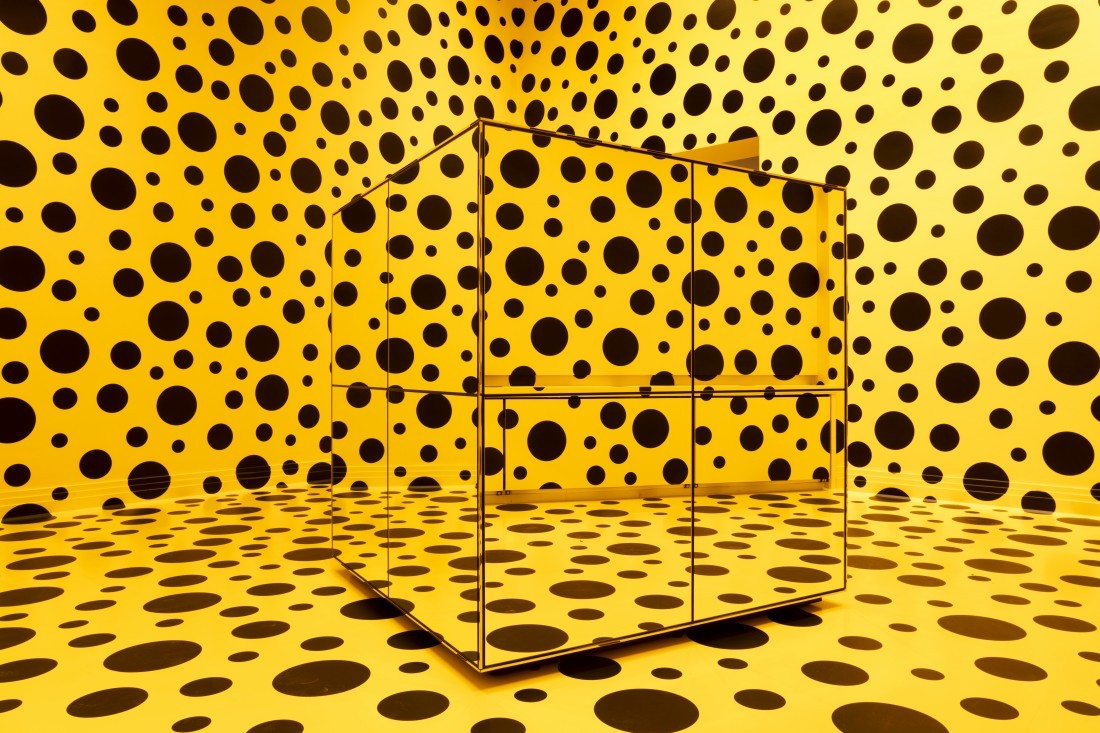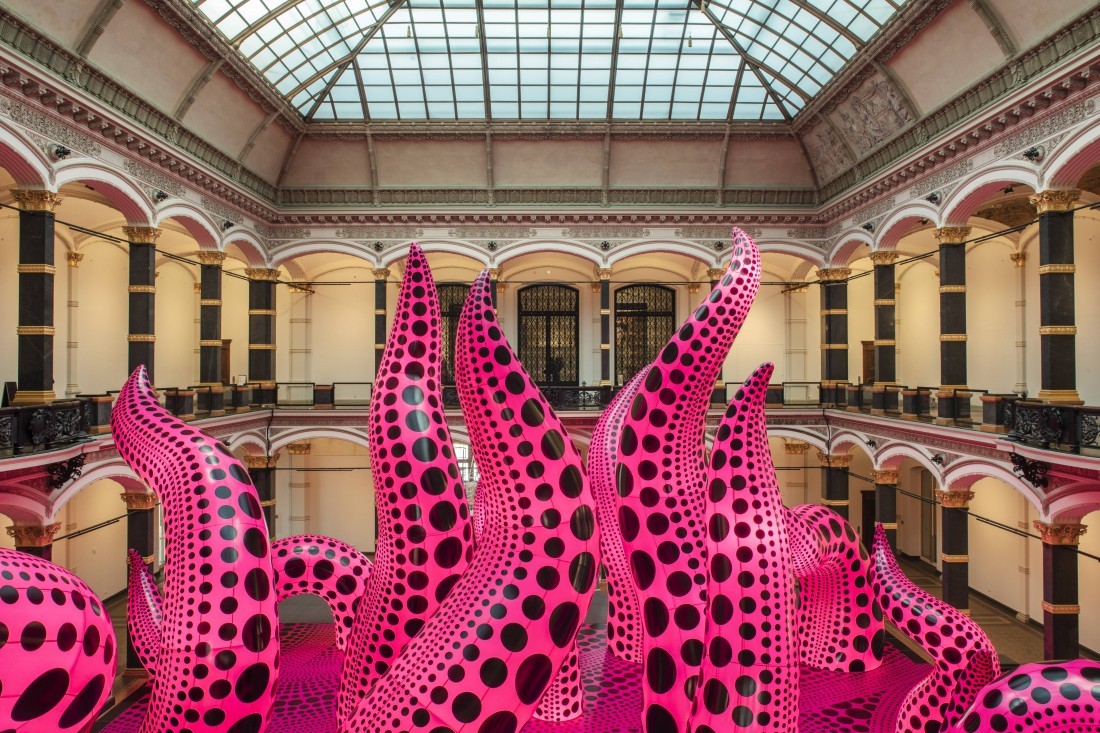Yayoi Kusama
If anyone can teach us how to adapt, transform and persevere, it’s Yayoi Kusama. Her retrospective at the Gropius Bau in Berlin was staged chronologically, giving the audience clear (in)sight into the unfolding of her life, practice and career. At aged 92, Kusama’s authority in the art world as the oldest living and highest paid female artist was reflected in the colossal and inflated hot pink, polka-dotted tentacles installed in the building’s inner courtyard but also in the numerous black and white reproductions of Kusama, shown alongside the artworks. These mega-sized photos, often taking the size of the museum walls, helped to reveal what the exhibition texts could not: regardless of Kusama’s ability to shapeshift (drawing, painting, sculpture, installation, light, film, performance …), there is a body at the root, as fluid as she wishes it to be.
In the first of many galleries, an immense photo of 23-year-old Kusama amidst floor-to-ceiling paintings meets the audience, followed by another of young Kusama in a fur-collared coat, the latter printed on a giant hanging fabric. These rooms contained the artist’s earliest works, including those from her first two solo shows in Matsumoto in 1952. Made up of small to medium-sized framed drawings and oil paintings, they’re simple but stunning in composition, the colours surprisingly dispirited: muddy, bloody and dark. In Accumulation of the Corpses, 1950, for example, thick and curving rustred ropes rise from the bottom of the frame, taking on sinister figurations. Behind, a barbed-wire fence delineates a horizon.

Yayoi Kusama, The Spirits of the Pumpkins Descended Into the Heavens, 2021, Gropius Bau, Berlin. Photo: Luca Girardini.
Four years later, Kusama began what would later become her signature. In the abstract painting titled Heart, delicate black splotches occupy the internal space of a strawberry- coloured, organic shape enclosed in a black ether. These images are unexpectedly personal, as perhaps only small artworks can be, bringing us close into a dark and mysterious intimacy that in Kusama’s later works is lost to scale, effect and the depersonalization that sometimes follows expert technical skill.
In 1960, Kusama created the now famous Pacific Ocean, the first in her series of “Infinity Net” paintings. Ostensibly taking what she learned through the making of Heart, a sense of motion gained through repetitive brush strokes, she shifted to a snowier palette and thicker application. Applying countless circular dabs of white paint around small greyish-blue blobs, she increased the count towards the centre, implying a centrifugal force. In the Gropius Bau, this significant painting hangs as any other.
For those familiar only with Kusama’s mirror rooms, this retrospective helps define the artist as a painter, first. A gratifying discovery. But to talk of her paintings only in terms of their formal qualities is to ignore the result. Through surface, mark-making materials and repetitive gestures, Kusama became an artist who deals in (illusory) space, not just shape and colour. She became expert in positioning form and the viewer, between foreground and background, manifesting herself as a skilled interpreter of sensation while evading normative language.
To be clear, Kusama has always had a special relationship to form, space and time. After a life-altering childhood experience (forced to witness her father in a sexual act with his mistress), Kusama started hallucinating. The first episode involved thousands of talking flowers and pebbles (think polka dots) that eradicated the boundaries between her body and the material world. These visions would reoccur. In what I understand as an attempt to regain control, Kusama became obsessed with the idea of self-obliteration and her body’s relationship to infinity— to become infinite—making the dot synonymous with herself as subject and with the object also: “I wanted to show that I am one of the elements—one of the dots among millions of dots in the universe” (Kusama, Gropius Bau). For the artist, the dot was a way to dissolve-into rather than disappear, to become-with the world.

Yayoi Kusama, A Bouquet of Love I Saw in the Universe, 2021, Gropius Bau, Berlin. Photo: Luca Girardini.
As a woman who understood early on this interwovenness of all things, who wanted to share the idea of unboundedness (which she sometimes called “love”), Kusama is genius. Through the dot, she cultivates a visual language so fluid it’s capable of breaking down not only creative but also social and environmental boundaries. Take, for instance, her quirky Driving Image, 1966, which hybridized installation, performance, painting, sculpture and fashion via TV commercials, sex, furniture, macaroni and the polka dot. “When we obliterate nature and our bodies with polka dots, we become part of the unity … I become part of the eternal … in Love” (Kusama, Gropius Bau).
Maybe it was the deliberate selection of artworks made by Gropius Bau curators, but I expected to be overwhelmed and was not. Rather than confront a dizzying number of self-reflective funhouse spectacles (Kusama’s work can be entertaining), I gained an explicit appreciation for Kusama’s shadow self, and in turn my own. For Kusama, the unrest and violence of WWII, familial instability, theft of her creative property by prominent American male artists, mental illness—all nurtured an other-side-of-the-mirror character, running parallel to ours in a spotted universe Kusama continually asks us to experience, to share our own shadow selves.
If we flip the script and view Kusama’s dots as negative rather than positive space, we are faced with a porousness that might actually be more generative, given the ideology behind them. To “obliterate,” to “dissolve” and, in some instances, “escape” are all words more attuned to emptiness rather than solid form. Kusama-as-dot-aspores exists, as does her work, in a constant flow, oscillating between foreground and background, technical discipline and surrender. Her ability to dissolve, as Alex Quicho writes in a recent C Mag article, like “sugar, yet reassemble just as easily and at will, seems an indicator of secure personhood.” I see, now, her body, the artist, the identity, the story, the dot, as one of paradox: constantly coming into and out of form. Situating herself (and the viewer) in her work—visibly, physically, metamorphically—Kusama begs us to counter separation, hate and fear with more fluid survival tactics, with a porousness. With a form that is space, with a space that is a form. ❚
“Yayoi Kusama: A Retrospective: A Bouquet of Love I Saw in the Universe” was exhibited at Gropius Bau, Berlin, from April 23 to August 15, 2021.
Jasmine Reimer is an artist and writer based in Berlin and Toronto. Her future projects include a group exhibition at Kohta Kunsthalle in Helsinki, and authoring a book about female Canadian crafters and spirituality, the second book Reimer will publish after her 2017 collection of poetry titled Small Obstructions.

